Mountain of Blessings
The title ‘Dalai Lama’ is given to the spiritual leader of the Gelug (Yellow Hat) – the newest and the most dominant of the four major schools of Tibetan Buddhism. The Dalai Lama is considered a symbol of unification, representing Buddhist values and traditions. The Dalai Lama is considered to be a successor to a line of tulku, (keepers of knowledge/teachings), who are believed to be incarnations of the Bodhisattva; beings who refrain from reaching enlightenment out of compassion for those who cannot and are suffering as a result. Dalaiis derived from the Mongolian dalaivan gan or dalaiin Kan (ocean/great) and, in combination with the Tibetan word བླ་མ་ (master/guru), forms the title Dalai Lama, literally, master of the ocean or ocean guru.
The First Dalai Lama
Gendun Drupa (1391–1474) was the first Dali Lama and received the title, posthumously, after 1578. Born in a cattle pen in Shabtod, Tsang, Pema Dorje was the son of nomads. After the death of his father in 1398, unable to provide for him, his mother sent him to his uncle, a monk at Narthang monastery where he spent much of his childhood and adolescence. The monastery ran the largest printing press in Tibet and its expansive library attracted scholars from across the region. As a result, Gendrun received an education which was far more extensive than was considered normal at the time, being exposed to a diverse range of spiritual schools, scriptures and ideas and studying Buddhist philosophy in great detail.
Pema Dorje was ordained by the Abbot of Narthang monastery in 1405 and took the name Gendun Drup. On recognising him as an exceptionally gifted pupil, the Abbot was particularly attentive to his studies and tutored him personally. Within 12 years he completed the 12 grades of monkhood and took the order’s highest vows. Soon after the completion of his training, Gendun left Narthang to travel to specialist monasteries in Central Tibet. It was during this time that Gendun met Je Tsongkhapa, the founder of the Gelugpa school of Buddhism, and became his student. This meeting and the subsequent development of their spiritual relationship was of great significance. Following the death of Tsongjkapa’s immediate successor, Gendun Drup became the leader of the Gelugpa, eventually becoming the Abbot of Draping.
The Gelugpa school expanded exponentially while under Gendun Drup and he established the Tashi Lhunpo (mountain of blessings) Monastery in Shigatse in 1447, which became the fourth greatest Gelugpa Monastery in Tibet. Gendun remained abbot at Tashi Lhunpo until his death in 1474, and it later became the headquarters of the Pachen Lamas (the great scholars). Gendun Drup died at the age of 84 in 1474 after a visit that was to be his final trip to Narthang Monastery. It is said that he died in a blaze of glory, attaining the state of Buddha, after returning to Tashi Lhunpo. His physical remains were put to rest in a stupa adorned in silver at Tashi Lhunpo Monastery.
Rebirth
Reincarnation, also known as phowa, is the idea of the successive transfer of consciousness to another physical body. This was originally an indigenous belief, traces of which can be founded in the Tibetan Bon religion. Bon preceded Buddhism, however, there are debates among scholars regarding the relationshipbetween the two, with some arguing that Bon is a variation of modern Tibetan Buddhism. The Dalai Lama has currently reincarnated fourteen times since 1474. Upon the mortal death of the Dalai Lama, a consultation takes place with the Nechung Oracle in search of the Llama’s yangsi, (their reincarnation). During this time, high Lamas often claim to have a vision of where the Dalai Lama’s yangsi is located. If the Dali Lama is cremated, the direction of the smoke is usually used as an indicator of the direction of where the expected location of the yangsi is to be found.
Although the concept of reincarnation is one that is central to Buddhist philosophy, it is believed that most ordinary beings forget their past life in the process of death, which is considered as the intermediate state between past and future lives. The process of rebirth takes two forms: rebirth from karma or destructive emotions, and rebirth through compassion and prayer. Rebirth through compassion and prayer is for the benefit of others, and those who go through this process have the ability to choose their time and place of birth, as well as their future parents.
The Eight Symbols of Buddhism
Astamangala, the eight auspicious symbols of Buddhism, are signs of spiritual and material well-being. They are: the parasol, the pair of golden fish, the treasure vase, the white lotus, the conch shell, the endless knot, the victory banner and the wheel of Dharma. These symbols are used to welcome high lamas by either painting these symbols on the floor or creating colourful sand mandalas. Buddhist Monks from Tashi Lhunpo Monastery visited St Andrews in June 2023 and constructed a sand mandala in Butts Wynd at the University over three days as part of the Sixth Annual Conference of European Academy of Religion.
Each of the auspicious symbols has a correspondence.
The Dharmachakra or Wheel of Dharma with its eight spokes represents the Noble Eightfold Path: right thought, view, action, livelihood, speech, effort, concentration and mindfulness. The wheel also symbolises movement, continuity and change.
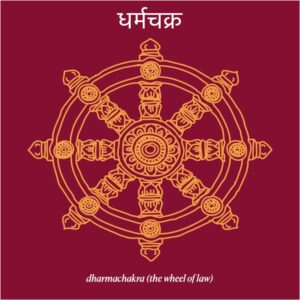
The Parasol represents protection and royalty. As an item that only the wealthy and powerful could afford in ancient times, it represents protection from negativity.
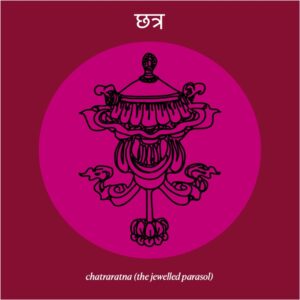
The Pair of Golden Fish, one male and one female, symbolise spiritual release from suffering in samsara – the cycle of death and rebirth. Carp are most commonly depicted as they are generally regarded as sacred due to their beauty, size and long lifespan.

The White Lotus signifies spiritual purity, as it emerges from the mud and appears clean on the surface of water producing a beautiful flower. This process is also reflective of the stages of Dharma representing the journey from samsara, purification and finally enlightenment.
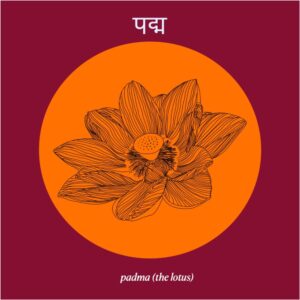
The Conch Shell signifies the Buddha’s enlightenmentas the process of blowing into the shell and the noise it produces awakens the world from the ‘sleep of ignorance’.
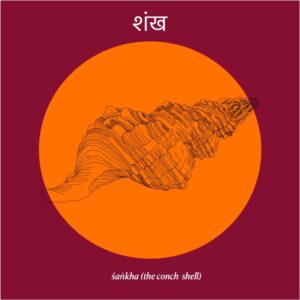
The Endless Knot has no beginning and end, representing the cycle of rebirth.
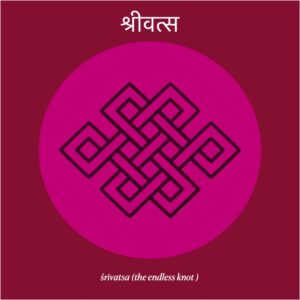
The Victory Banner in Tibetan Buddhism and Indian cosmology is considered to be the centre of the universe, symbolising the triumph of Dharma teachings over disharmony and negativity.
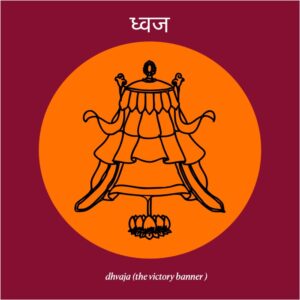
As observers and allies look for more information, additional insights and reflect on the meaning and significance of the Dalai Lama, we’ve collated some sources to help you find out more (see below).
Words and images by Amrita Rahman
Find out more about the information in this article at:
‘Dalai Lama’, Dictionary.com, https://www.dictionary.com/browse/dalailama
’Introducing Tibetan Buddhism’, Geoffery Samuel, Routledge Taylor& Francis Group, 2012
‘Painting the Eight Auspicious Symbols of the Dalai Lama, Part 2’, Dakini As Art, Buddhist Door Global, 2015, https://www.buddhistdoor.net/features/painting-the-eight-auspicious-symbols-for-the-dalai-lama-part-2/#:~:
‘Reincarnation’, His Holiness The 14th Dalai Lama Of Tibet, https://www.dalailama.com/the-dalai-lama/biography-and-daily-life/reincarnation
‘Short Biographies of the Previous Dalai Lamas’, His Holiness The 14th Dalai Lama Of Tibet, https://www.dalailama.com/the-dalai-lama/previous-dalai-lamas/previous-dalai-lama
‘Tibet: A History’, Sam Schaik, Yale University Press, 2011
‘Tibetan Monks of the Tashi Lhunpo Monastery’, Access All Areas, https://www.accessallareas.info/artist/tibetan-monks-of-the-tashi-lhunpo-monastery/#:~:text=Occupying%20a%20central%20position%20in,and%20traditions%20of%20Tibetan%20Buddhism (just removed the full stop to make it hyperlink_
“The Dalai Lama”. BBC. 21 September 2006. Archived from the original on 4 November 2019. Retrieved 17 May 2008. https://www.bbc.co.uk/religion/religions/buddhism/people/dalailama_1.shtml
‘The Eight Auspicious Symbols of the Dalai Lama’, Tibetan Buddhist Art, 2009, https://www.tibetan-buddhist-art.com/dalai-lama-8-auspicious-symbols/